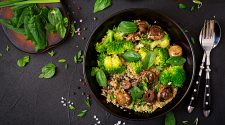What do milk, eggs and flour have in like manner? They are all fixings in kids’ most loved treats – like birthday cake, brownies and treats – yet they are additionally all piece of what pediatric anaphylaxis expert Eli Silver, MD, calls the Big 8. “The eight sustenances that most usually cause unfavorably susceptible responses are milk, eggs, peanuts, tree nuts, wheat, soy, fish and shellfish,” says Dr. Silver.
While there may not be much lobster on the school cafeteria menu, there is a lot of famous kids’ sustenance that can concern folks of youngsters with unfavorable susceptibilities: peanut spread sandwiches, scaled down containers of milk, bundles of wafers and then some. The way to keeping your kids protected at school? Correspondence.
Correspond With Your Allergist
As indicated by Dr. Silver, one in every 13 youngsters has some manifestation of nourishment unfavorable susceptibilities. An unfavorably susceptible response happens when the body recognizes a sustenance as an issue risk. “The resistant framework fundamentally produces an assault against the sustenance,” says Dr. Silver. This can result in the youngster to experience side effects like hives, queasiness, regurgitating and trouble relaxing. The dominant part of kids are diagnosed with their unfavorable susceptibilities at an exceptionally youthful age.
What numerous folks don’t understand, nonetheless, is that numerous children will create a safe resilience for sustenances that used to provide for them hypersensitive responses. “Drain and eggs are the most widely recognized unfavorable susceptibilities,” says Dr. Silver, “yet most children become out of those unfavorable susceptibilities when school begins.”
Not all youngsters with unfavorable susceptibilities will exceed them, and not all nourishments will in the long run be endured. Serious nut hypersensitivities, case in point, have a tendency to last. Anyway all folks of kids with nourishment unfavorable susceptibilities ought to have their children retested with a board-affirmed allergist before beginning school.
“A ton of children are diagnosed in earliest stages,” says Dr. Silver, “so we have to rehash the testing to check whether they are still unfavorably susceptible.” Work with your specialist to focus the most exceptional rundown of nourishments your tyke needs to stay away from.
Correspond With Your School
On the off chance that it would seem your kids still has unfavorable susceptibilities, its pivotal that you impart this data to class authorities. “Clarify to the school that your kid could have an extreme response and that they have to be exceptionally watchful not to uncover your tyke,” says Dr. Silver.
Give managers, instructors and medical caretakers with cautious documentation of the points of interest of your youngster’s anaphylaxes. Incorporate crisis contact data and a particular rundown of the sustenances that must be dodged. You may need to think about requesting as a therapeutic caution arm ornament. Make certain to get some information about any strategies set up in regards to the organization of epinephrine, a hormone that can be utilized to check an unfavorably susceptible response.
Most schools will as of now have a crisis convention set up, in addition to preventive measures like nut free tables. Remember that your youngster is probably not by any means the only child at school who needs to keep away from nutty spread treats or egg-mixed greens sandwiches. “Around two children in every classroom have a nourishment unfavorable susceptibility,” says Dr. Silver. With open correspondence and the right precautionary measures, you can keep your youngster sheltered in the cafeteria.
Contact the Food Challenge Clinic at University Hospitals Rainbow Babies & Children’s Hospital to see whether your youngsters have outgrown their nourishment allergies.















